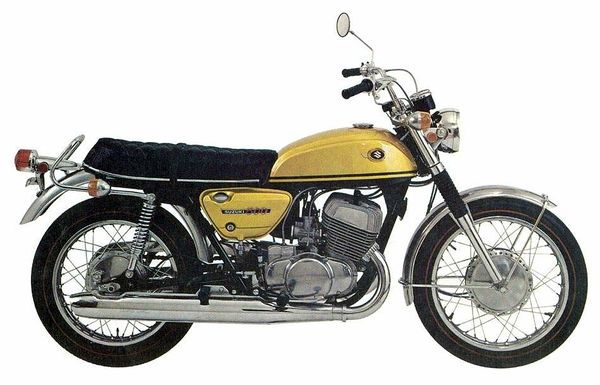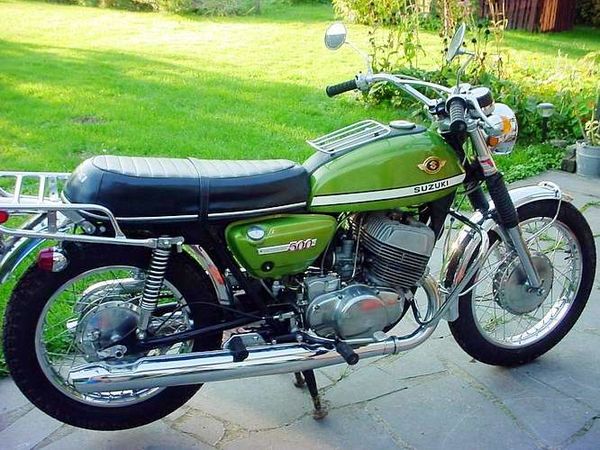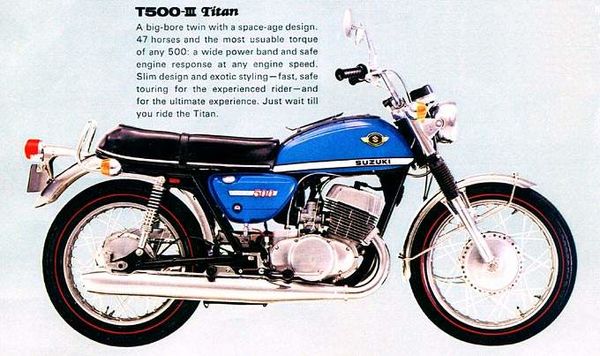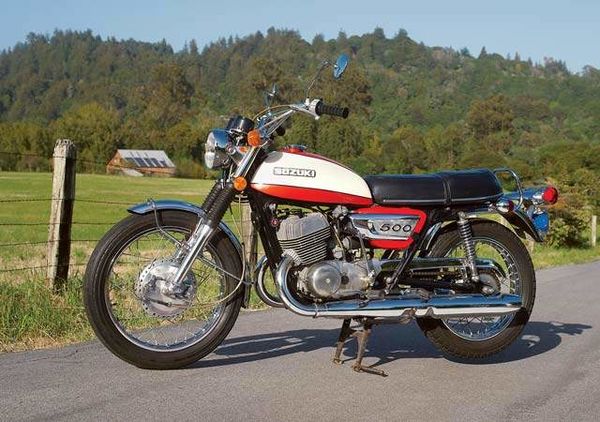Suzuki T500 Titan
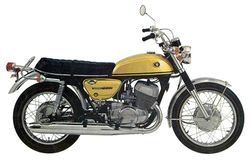 |
|
| Suzuki T500 Titan | |
| Manufacturer | |
|---|---|
| Production | 1969 - 70 |
| Engine | Two stroke, parallel two cylinder |
| Compression ratio | 6.6:1 |
| Transmission | 5 Speed |
| Frame | Dual downtube cradle |
| Suspension | Front: Telescopic forks Rear: Dual shock absorbers |
| Brakes | Front: Drum Rear: Drum |
| Front Tire | 3.00-18 |
| Rear Tire | 3.25-16 |
| Wheelbase | 1455 mm / 57.3 in |
| Weight | 186 kg / 410 lbs (dry), |
| Recommended Oil | Suzuki ECSTAR 10w40 |
| Manuals | Service Manual |
Engine[edit | edit source]
The engine was a Air cooled cooled Two stroke, parallel two cylinder. The engine featured a 6.6:1 compression ratio.
Chassis[edit | edit source]
It came with a 3.00-18 front tire and a 3.25-16 rear tire. Stopping was achieved via Drum in the front and a Drum in the rear. The front suspension was a Telescopic forks while the rear was equipped with a Dual shock absorbers. The bike weighed just 186 kg / 410 lbs. The wheelbase was 1455 mm / 57.3 in long.
Photos[edit | edit source]
Overview[edit | edit source]
Suzuki T 500 Titan
In 1968, everyone knew the only good parallel twins came out of England. And four-stroke engines powered all of these. Two-strokes, the conventional thinking went, were noisy, smelly and high-strung. With its big-bore T500, Suzuki meant to change all that. Originally marketed as the Cobra, the first T500s garnered more fame for their extreme thirst for fuel than for their obvious merits: clean lines, good handling and, unlike most two-strokes, a smooth (at least at low rpms) low-revving engine. At 412lb (187kg) they werent exactly light, but considering that a comparably sized Triumph Tiger weighed a few pounds more but put out a few horses less, they were a tempting option to the British mounts. Early Japanese bikes were and are often faulted for their mediocre handling, but from the beginning the T500 drew praise for its good road manners, and was a winner on the track as well as the street. A T500 won the 500cc class at the Isle of Man in 1970 and 1972. Even so, as much as the T500 was admired for its low-rpm pull, testers panned the engines performance at high revs. As one tester noted: To use the 500 to full rpm is an unrewarding experience, as ones foot can be firmly but steadily shaken off the footrest. The T500s front brake, a twin-leading shoe affair, also drew criticism, prompting one tester to quip, It is difficult to be enthusiastic about it, as it simply works. In 1969 the T500 Cobra gave way to the T500 Titan, with altered porting to help quench the bikes thirsty nature. Period testers applauded the bikes improved economy, but its front brake maintained to the end still drew criticism. Engine porting aside, Suzuki changed very little on the T500 during its seven year run. The gas tank and seat changed for 1969, but after that changes were limited to color options and minor upgrades in switchgear and hardware. When Suzuki stopped selling the bike in 1975, it was hard to tell a new T500 from a five-year-old model.
Source: Richard Backus,
So what changes had been made to the Cobra to convert it into the more appealing Titan? Some obvious changes were made to the appearance. The petrol tank was now a more pleasing shape, reminiscent of a familiar British design, as was the more conventional seat. Additionally, the front mudguard was much lighter and less valanced, the sidecover and oil tank were redesigned, the rear shocks were no longer shrouded and had exposed springs, American style cow-horn bars were introduced, new instruments and a passenger grab rail. Whilst the Cobra had the headlight cowl, instruments and rear shocks all color co-ordinated, the Titan was very shiny with abundant chrome wherever possible. The Titan was designed to bring the Suzuki 500 into the 70's, its styling was much flashier, leaner and more colourful. The Cobra had more in common with Suzuki's earlier mid 60's styling efforts with its bulbous, tall tank, complete with chrome side panels and knee rubbers, large sidecovers and studded seat. Enginewise, the Titan was little changed externally; but gone for good were the Cobra's 10 finned barrels to be replaced by 11 finned barrels with altered porting and new stronger pistons with larger piston porting. Quieter running was possibly one benefit of the new pistons as the piston to cylinder liner tolerance was much closer in the new motors. One outcome of the new pistons was a spate of piston skirt failures when the standard pistons were used in a sporting mode, i.e. over-revving the motor for extended periods. This was easily solved by using the heavier, stronger GT 750 pistons whose engines had precisely the same bore and stroke dimensions as the 500. The only other significant change to the motor was the dropping of the 34mm carburettors for 32mm Mikunis. There is no evident loss of power as a result and the intake howl is much the same; but, fuel consumption dropped markedly from 35mpg on the Cobra to around 50mpg on the Titan. Cruising at 65mph in the country it was possible to return 63mpg, which is not to bad on a loaded two stroke now is it?
Whilst the changes between the Cobra and the Titan were quite marked there was little change to the character and performance of the machine. Feel and handling had been improved by the use of a longer swingarm much earlier and the test riders of the time while unable to get overly excited about the handling commented favourably on the bikes open road stability. This stability was enhanced by the standard fitting of a friction steering damper.
Source:
| Make Model | Suzuki T 500 Titan |
|---|---|
| Year | 1969 - 70 |
| Engine Type | Two stroke, parallel two cylinder |
| Displacement | 492 cc / 30 cu in |
| Bore X Stroke | 70 x 64 mm |
| Compression | 6.6:1 |
| Cooling System | Air cooled |
| Lubrication System | Posi-force |
| Induction | 2 x 32 mm Mikuni carburetors |
| Starting | Kick |
| Max Power | 32.8 kW / 44 hp @ 7000 rpm |
| Max Torque | 50.8 Nm / 5.2 kgf-m / 37.5 lb-ft @6000 rpm |
| Transmission | 5 Speed |
| Final Drive | Chain |
| Frame | Dual downtube cradle |
| Front Suspension | Telescopic forks |
| Rear Suspension | Dual shock absorbers |
| Front Brakes | Drum |
| Rear Brakes | Drum |
| Front Tire | 3.00-18 |
| Rear Tire | 3.25-16 |
| Dimensions | Length: 2172 mm / 85.5 in Width: 835 mm / 32.9 in Height: 1125 mm / 44.3 in |
| Wheelbase | 1455 mm / 57.3 in |
| Dry Weight | 186 kg / 410 lbs |
| Top Speed (est) | 185 km/h / 115 mph |
